
views
- Check if your car has an old-style 4-stroke engine or an electronic ignition. Cars with electronic ignitions don't need any timing adjustments.
- Find your car's timing number with a timing light or gun while a friend revs the engine of your vehicle.
- Rotate your car's distributor to adjust the overall timing. Set your timing curve between 34 and 36 degrees if you don't know your car's optimum timing number.
Understanding Ignition Timing
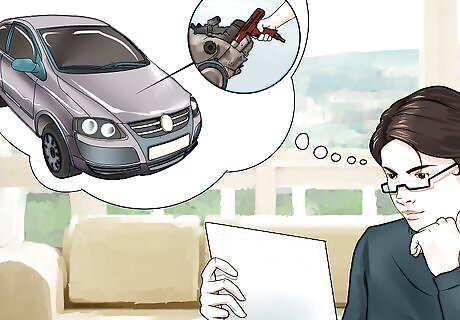
Learn if your car needs to be adjusted or not. Modern cars that are controlled by electronic ignitions don't need to have their timing adjusted, but old-style 4-stroke engines require that the timing be adjusted periodically to optimize the efficiency of the engine, making sure that the spark fires at the appropriate moment in the ignition cycle. If you hear telltale signs of the timing of your car not being quite right, such as pinging, backfiring, or if the car runs too rich or too lean, you will need to either take it to a mechanic or adjust the timing yourself.
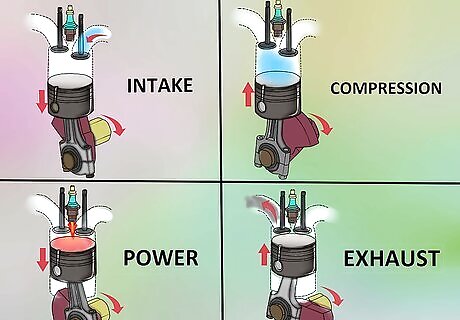
Understand the ignition cycle. The four "strokes" in the 4-cycle engine refer to the process of intake, compression, power, and exhaust. The timing of the ignition refers to the point between the compression and the power strokes at which the spark plug fires, creating the combustion that results in your horsepower, forcing the piston down into the cylinder. When the piston comes up during the compression stroke, just before the piston gets to the top of its compression stroke (which is called "top dead center"), the spark plug should fire. Over time, this tends to get misaligned somewhat, resulting in a less-than-optimum spark plug firing time. The distance before the "top dead" center is the ignition timing, and it's represented by a row of graded numbers on the balancer or flywheel through an access hole.
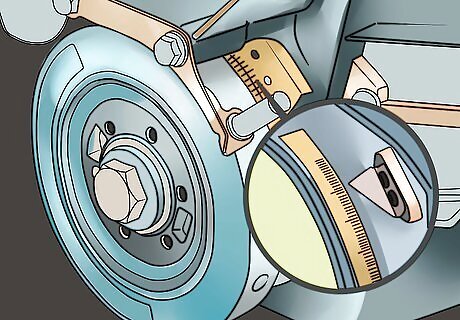
Learn the ignition timing number. Look for the ruler-style row of numbers on the front of the engine's harmonic balancer (or flywheel), which should have numbers above and below zero. Typically, when your car comes from the manufacturer, ignition base idle timing is set to a manufacture specification before top dead center. The timing advances as the engine's speed accelerates, however, resulting in a variable that will need to be periodically adjusted using a timing light. Numbers to the left of zero on the timing tape refer to the piston as it travels down, while numbers to the right of zero refer to the piston's upward motion. Moving the wheel right is called "advancing" the timing, while moving the wheel left is "moving back" the timing.
Checking Your Timing

Hook up your timing light or timing gun. Hook your timing gun up to the power and ground terminals on your car's battery, and hook the sensor that accompanies the timing gun to your number one cylinder spark plug wire. Follow the instructions particular to the timing light you're using to hook it up properly. The "gun" works by illuminating the timing marks in a strobe fashion as it spins, allowing you to see the point at which the spark plug is firing on the timing index. When the spark plug fires, the sensor sends a signal to the light, which strobes in the gun, illuminating the numbers at the proper moment.
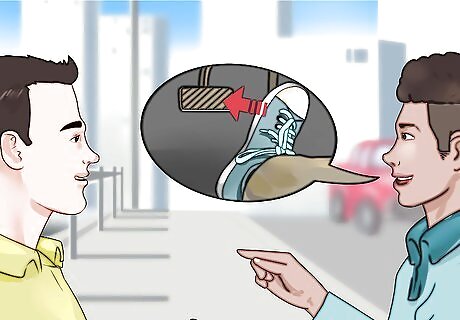
Have a helper rev the engine. To check your timing number and see how it is firing, have someone rev the engine while you illuminate the timing numbers with your light. You obviously want to make sure the car is in neutral, and keep your hands a safe distance from the engine as it revs.
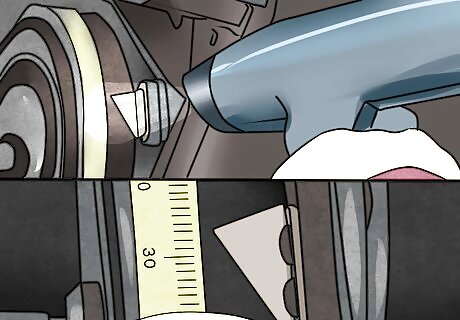
Shine the light directly onto the harmonic balancer and find the number. Though the wheel is turning, the light should seem to "freeze" it at a particular number. This is the timing number. Note the number of degrees to the right or left of zero. As the RPMs increase, the point at which the spark plug is firing should also increase somewhat. This is normal, because ignition works on a curve, allowing for the speed increase and adjusting the timing accordingly. To check for total timing, you want to be sure to rev the engine to at least 3500 RPMs. This will allow you to make sure the curve of the ignition timing is being set, as well as the initial timing.
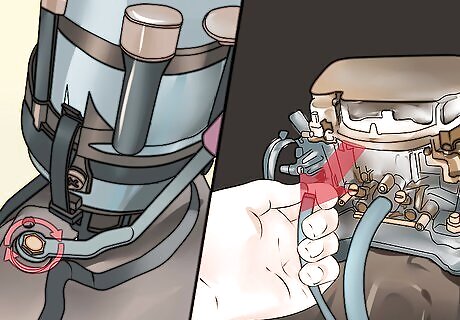
Account for vacuum timing, if necessary. If your car features vacuum timing advance in addition to mechanical timing, and you'll need to loosen the distributor adjustment bolt before you start the engine. Next, remove the vacuum advance hose from the carburetor and plug it with a rag to check your timing. Vacuum timing works by making minor adjustments at low RPM by rotating slightly to adjust for the timing.
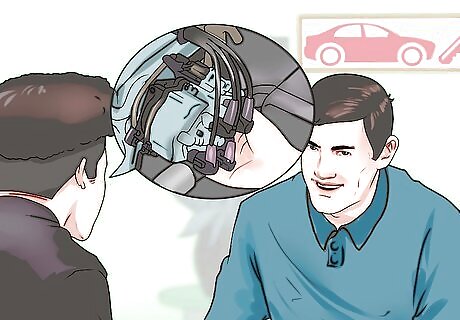
Adjust the timing, if necessary. Now that you've found your ignition timing number, how do you know if you need to adjust it? All models of cars will have differing timing values, depending on the year it was manufactured and the variety of transmission used. To learn whether or not you need to adjust your timing, find the optimum timing number for your make and model and adjust if necessary. If you don't know your timing number, talk to a licensed mechanic or employee at your local auto parts store to consult their manuals and find the proper timing number.
Adjusting the Timing

Loosen the bolt that secures the engine's distributor enough so that the distributor can be turned. To adjust your timing, all you need to do is turn the distributor housing one direction or the other, depending on whether or not you want to advance or move back the timing. If the rotor turns clockwise, you'll advance the timing by rotating the distributor counterclockwise, and vice versa. It'll take some touch to get it right, so it helps to have someone to rev the engine, check the number, and twist the distributor.
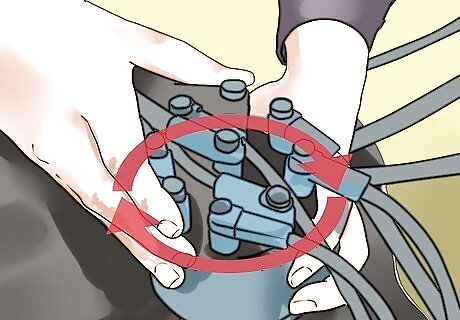
Adjust while the engine is at idle speed. Grab the distributor firmly and rotate it slowly to one side or the other. Continue rotating until the timing mark is in the correct position. Align the timing marks by continuing to move the distributor and checking with your timing light. When you've got it set where you want it, lock it back down by tightening the distributor bolts. Reconnect vacuum hoses.
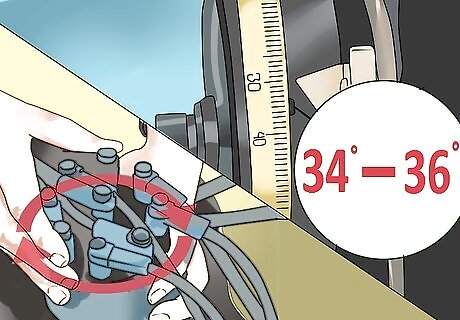
When in doubt, total timing should be somewhere between 34 and 36 degrees. A typical small-block Chevy's timing curve needs to be set somewhere in this range for maximum performance, when the engine is being revved at 3500 RPM. At this point, the timing should stop advancing and should remain steady. Total timing minus your base timing number should meet your engine specification for total advance degrees. If the number is not as specified then you may have a distributor mechanical advance problem.
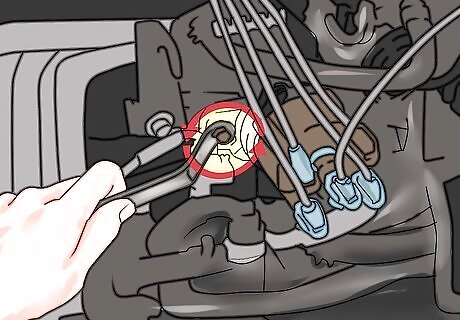
Tighten the distributor bolt when you are satisfied the timing is set correctly.

















Comments
0 comment